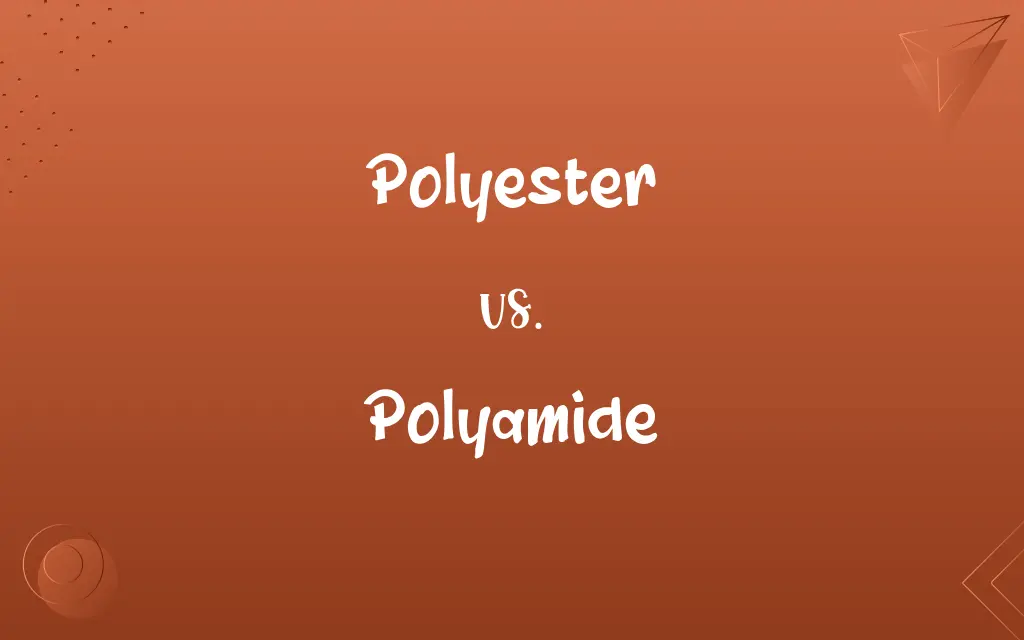Polyester vs. Polyamide: Know the Difference

By Shumaila Saeed || Published on January 29, 2024
Polyester is a synthetic fiber known for its durability and resistance to wrinkles and shrinking, while polyamide, also synthetic, excels in strength and elasticity.

Key Differences
Polyester is a synthetic fiber made from polyethylene terephthalate (PET), known for its durability and resistance to various chemicals. Polyamide, commonly known as nylon, is made from long-chain polyamides and has excellent strength and flexibility.
Shumaila Saeed
Jan 29, 2024
Polyester has low water absorption, making it quick to dry and less prone to mildewing. Polyamide absorbs more water but offers better sweat-wicking properties, making it comfortable for activewear.
Shumaila Saeed
Jan 29, 2024
Both materials are durable, but polyester typically has higher resistance to UV and heat. Polyamide is more resilient, with better stretch and recovery, making it ideal for applications where flexibility is essential.
Shumaila Saeed
Jan 29, 2024
Polyester fabrics are often smooth and less prone to wrinkling, making them suitable for various garments. Polyamide feels softer against the skin, providing a more comfortable wear, especially in garments that require close skin contact.
Shumaila Saeed
Jan 29, 2024
Both materials are not biodegradable, but polyester is often recycled more effectively, reducing its environmental footprint. Polyamide’s manufacturing process is more energy-intensive, raising concerns about its environmental impact.
Shumaila Saeed
Jan 29, 2024
ADVERTISEMENT
Comparison Chart
Chemical Composition
Made from polyethylene terephthalate (PET)
Made from long-chain polyamides
Shumaila Saeed
Jan 29, 2024
Texture and Comfort
Smooth, less wrinkling
Softer, more comfortable against the skin
Shumaila Saeed
Jan 29, 2024
Environmental Impact
More effectively recycled
More energy-intensive manufacturing
Shumaila Saeed
Jan 29, 2024
ADVERTISEMENT
Polyester and Polyamide Definitions
Polyester
Polyester is a synthetic resin in which the polymer units are linked by ester groups, used to make fabrics.
The polyester curtains were chosen for their durability and ease of care.
Shumaila Saeed
Jan 03, 2024
Polyamide
Polyamide fabrics are known for their high strength and excellent resilience.
The polyamide ropes were chosen for the climbing expedition due to their superior strength.
Shumaila Saeed
Jan 03, 2024
Polyester
Polyester is also used in various applications outside of textiles, including containers and bottles.
The water bottle was made from recycled polyester, aligning with the company's sustainability goals.
Shumaila Saeed
Jan 03, 2024
Polyamide
Polyamide is a polymer with repeating units linked by amide bonds, commonly used in textiles.
The polyamide carpet was remarkably soft and durable, ideal for high-traffic areas.
Shumaila Saeed
Jan 03, 2024
Polyester
In textiles, polyester is a category of polymers used in manufacturing strong and durable fabrics.
Her dress was made of 100% polyester, ensuring it wouldn't wrinkle during travel.
Shumaila Saeed
Jan 03, 2024
ADVERTISEMENT
Polyamide
Besides textiles, polyamides find use in plastics, films, and coatings.
The kitchen utensils made of polyamide were popular for their durability and heat resistance.
Shumaila Saeed
Jan 03, 2024
Polyester
Polyester can refer to a fabric or textile made from this polymer.
The polyester jacket was lightweight yet resistant to wind and rain.
Shumaila Saeed
Jan 03, 2024
Polyamide
In the textile industry, polyamide refers to a group of synthetic fibers, including nylon.
Her activewear was made of polyamide, offering excellent elasticity and comfort.
Shumaila Saeed
Jan 03, 2024
Polyester
As a material, polyester is known for its resistance to shrinking and stretching.
Their choice of polyester uniforms meant less hassle with maintenance and laundry.
Shumaila Saeed
Jan 03, 2024
Polyamide
Polyamide is often used for technical applications due to its thermal and chemical resistance.
The engineer selected polyamide components for the machinery because of their heat resistance.
Shumaila Saeed
Jan 03, 2024
Polyester
Any of numerous synthetic polymers produced chiefly by reaction of dicarboxylic acids with dihydric alcohols and used primarily as light, strong, weather-resistant resins in boat hulls, textile fibers, adhesives, and molded parts.
Shumaila Saeed
Jan 02, 2024
Polyamide
A polymer containing repeated amide groups, as in various kinds of nylon.
Shumaila Saeed
Jan 02, 2024
Polyester
A wrinkle-resistant fabric of fibers made from any of these resins.
Shumaila Saeed
Jan 02, 2024
Polyamide
(chemistry) Any of a range of polymers containing amide (or peptide) repeat units; examples include proteins and nylon.
Shumaila Saeed
Jan 02, 2024
Polyester
Any of numerous synthetic resins; they are light and strong and weather resistant
Shumaila Saeed
Jan 02, 2024
Polyester
A complex ester used for making fibers or resins or plastics or as a plasticizer
Shumaila Saeed
Jan 02, 2024
Repeatedly Asked Queries
What are the main uses of polyamide?
Polyamide is used in textiles, automotive parts, carpets, and various industrial materials.
Shumaila Saeed
Jan 29, 2024
Does polyamide absorb water?
Polyamide absorbs more water than polyester but dries relatively quickly.
Shumaila Saeed
Jan 29, 2024
Are polyester fabrics breathable?
Polyester is less breathable than natural fibers but certain weaves can improve its breathability.
Shumaila Saeed
Jan 29, 2024
Is polyester water-resistant?
Yes, polyester is water-resistant and dries quickly.
Shumaila Saeed
Jan 29, 2024
What is polyester used for?
Polyester is widely used in clothing, home furnishings, and industrial applications.
Shumaila Saeed
Jan 29, 2024
Can polyester be stretched?
Polyester resists stretching and shrinking but isn't as elastic as polyamide.
Shumaila Saeed
Jan 29, 2024
Is polyamide environmentally friendly?
Polyamide's production is more energy-intensive, raising concerns about its environmental impact.
Shumaila Saeed
Jan 29, 2024
Is polyester suitable for sensitive skin?
Polyester might irritate sensitive skin, especially if not blended with softer fibers.
Shumaila Saeed
Jan 29, 2024
How does polyester perform in heat?
Polyester has good resistance to heat and UV light.
Shumaila Saeed
Jan 29, 2024
Does polyamide wrinkle easily?
Polyamide resists wrinkling more than many natural fibers.
Shumaila Saeed
Jan 29, 2024
Is polyester good for the environment?
Polyester's impact on the environment is a concern due to its non-biodegradable nature and reliance on fossil fuels.
Shumaila Saeed
Jan 29, 2024
Is polyamide good for outdoor clothing?
Yes, polyamide's strength and resilience make it suitable for outdoor and activewear.
Shumaila Saeed
Jan 29, 2024
Can polyester be recycled?
Yes, polyester can be recycled, and recycled polyester is commonly used in textiles.
Shumaila Saeed
Jan 29, 2024
How does polyamide perform in cold weather?
Polyamide performs well in cold weather, maintaining its flexibility and strength.
Shumaila Saeed
Jan 29, 2024
Are polyamide fabrics comfortable?
Yes, polyamide fabrics are known for their softness and comfort.
Shumaila Saeed
Jan 29, 2024
Can polyester be dyed easily?
Polyester can be dyed, but it requires disperse dyes and often high temperatures.
Shumaila Saeed
Jan 29, 2024
Can polyamide withstand heavy use?
Yes, polyamide is highly durable and suitable for heavy use.
Shumaila Saeed
Jan 29, 2024
How is polyester made?
Polyester is made through a chemical reaction involving petroleum, air, and water.
Shumaila Saeed
Jan 29, 2024
What is the production process of polyamide?
Polyamide is produced through the polymerization of monomers with amide bonds.
Shumaila Saeed
Jan 29, 2024
Are polyamide products expensive?
Polyamide products can be more expensive than polyester due to their higher production costs.
Shumaila Saeed
Jan 29, 2024
Share this page
Link for your blog / website
HTML
Link to share via messenger
About Author
Written by
Shumaila SaeedShumaila Saeed, an expert content creator with 6 years of experience, specializes in distilling complex topics into easily digestible comparisons, shining a light on the nuances that both inform and educate readers with clarity and accuracy.







































































